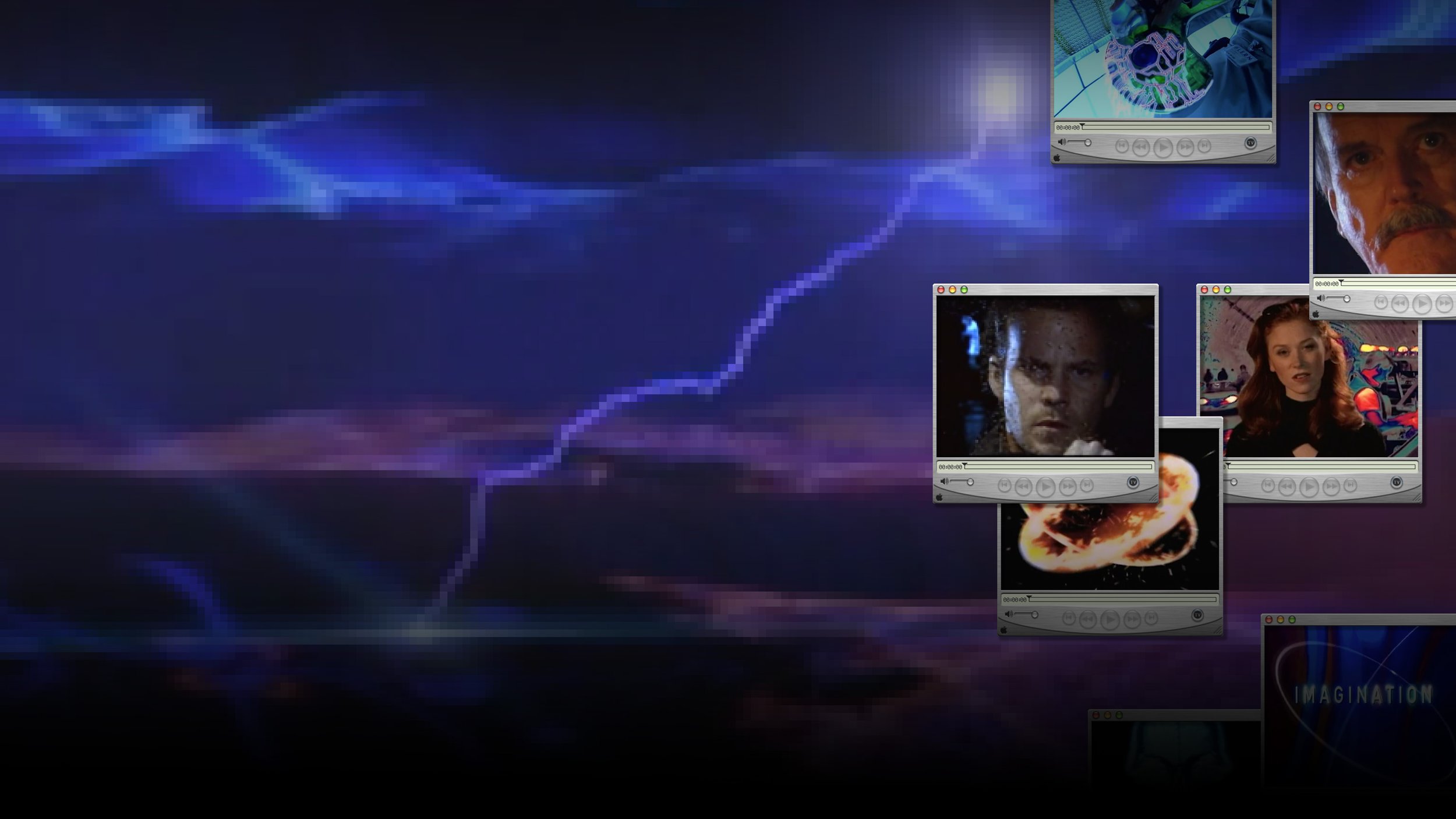
Garret Harkawik | 2.16.23
“NOTHING IS REAL UNTIL IT IS PERCEIVED”
-Paul Pentcho, Quantum Project
We recently hit the zenith of streaming services, with legacy media rushing to get as many platforms up and running as quickly as possible. The casualties were equally as swift: Quibi crashed and burned, CNN+ barely launched before shuttering, and HBO Max drastically reduced its library while simultaneously dumping several finished projects into the abyss.
These failures offered a real time look at what was previously a new media thought experiment: what happens to a streamer’s exclusive content if it goes under?
In the case of Quibi, its shows were auctioned off to Roku, so the masses will continue to have unfettered access to “Murder House Flip,” and this is the most likely outcome: content libraries will get passed between services when they go under. Of course there was the completed Batwoman film that HBO Max shelved, but it was never actually released. But, is this a fate other content is destined for?
If history is an indicator, the answer is yes.
It turns out, there is a case study to examine, and it’s one from before we even knew what streamers like Netflix were. It was the first film made exclusively for internet distribution, and now, it’s seemingly impossible to find.
The film is called Quantum Project, released online in May of 2000. It’s longline is thus:
“Quantum Project is the story of physicist and prodigy Paul Pentcho (Stephen Dorff), whose exploration of the quantum universe leads him on a collision course with life, destiny, and true love.”
Based on a few contemporaneous reviews, it seems the plot goes something like this: Paul Pentcho is working on extremely scientific Quantum computing stuff, blows his own mind, visits his sad, regretful father, tries to rekindle a past relationship, then gets into several car crashes. And perhaps some of these things were merely happening…in his mind? Adding to the new media intrigue was the fact that the filmmakers released three versions of the film — labeled 3.0, 3.5, and 4.0 — simultaneously. The content of each was largely the same, but scenes were rearranged to create a different series of events.
Quantum Project wasn’t just distributed online, it also attempted to communicate in the language of the internet, at least according to the Stephen Simon, one of the film’s producers.
In an LA Times article about the film he said:
“When Dorff’s character thinks, for example, his thought process is depicted as a computer screen with a tool bar. When he’s thinking of a particular person, you will see dates and times on the tool bar, the same way you would if you were checking e-mail. If he feels danger, things happen that are very similar to the caution flags that come up on your computer when something goes wrong. When you see it, you’ll understand.”
When you see you’ll understand. Unfortunately for us, we can’t see it. All that is left online of the film is the trailer:
Based on the trailer, Quantum Project is a cheap-looking shot-on-video sci-fi thriller, with an almost inexplicable $3 million budget — a surprising number considering it’s only 32 minutes long. The general vibe seems to be closer to a “playable movie” CD-ROM game than a feature film. Presumably most of the budget went towards hiring Stephen Dorff, Fay Masterson, John Cleese, and Oscar-winning set-designer-turned-director Eugenio Zanetti.
The millions of dollars spent and known talent are what set it apart from a small group of more independently-minded internet exclusive films and series. Five years earlier The Spot launched online, which was an independently-produced web series in the vein of Melrose Place (and, like Quantum Project, seems to be excised from the internet). Also notable was WhirlGirl, an independently produced animated series that would be picked up by Showtime. It premiered online and on TV simultaneously. Quantum Project certainly wasn’t the first piece of media to be made and shown exclusively online, but it was the first to be made for a specific platform: SightSound Technologies, a digital distribution website that was ages ahead of its time.
SightSound Technologies launched in the mid-90’s by selling music online. In 1999, they added films for purchase and rental. Their first film sold online was Darren Aronofsky’s Pi. But SightSound was decidedly not an entertainment company; it was in the business of technology. And being based in Pittsburgh meant that they were far outside the realm of Hollywood. And so Quantum Project was ultimately more of a showcase for their technology than a thrilling piece of cinema.
The production was rushed. Only five or six months elapsed from production wrapping and the film premiering. Due to both the tight turnaround and the utilization of early HD cameras, editor Jay Nelson was editing the film while it was being shot, a practice that is common now but completely unheard of back then.
And, according to Jay, there were other aspects of the production that were considered cutting edge for the time.
“What was interesting was that the cameras, which were two Panasonic HD cameras, the serial numbers were one and two. There were two decks and two cameras, you’d have to dub the HD tape to three quarter inch tape, and then digitize that into Avid.”
And Jay’s enthusiasm for the project remains, twenty years later. He feels strongly that Quantum Project deserves a place in film history.
“People didn’t understand the concept of online content, we were inventing it at the time.”
Others involved were less enthusiastic about the project. Stephen Dorff, speaking to Wired at the film’s premiere, couldn’t even muster vague excitement:
"To me, it's a side project, an experiment," he said. "I like making movies for the big screen."
Screengrabs of SightSound’s website.
Jay’s description of the production paints a somewhat chaotic picture, with him trying to work with the VFX team while the film was still being shot, sometimes being unclear on what the effects were meant to depict.
The end product was a concern as well. No one was sure how the film would look when compressed for the internet. Cinematographer Robert Primes didn’t mince his words when speaking to Wired for a different article about the film:
“The quality of downloads is so bad that I tried to put it out of my mind,” he said. “If I’d really thought of the jerky motion and poor resolution, it would have broken my spirit.” Not wanting to see that hard work squandered on a computer monitor, Primes once suggested that the movie be distributed on DVD as well. But, as he recalls, “The SightSound guys just said, ‘No trucks.’”
I asked Jay if they would do test exports to see what shots would look like online and was surprised to learn that the answer was no, because at the time AVID wasn’t capable of exporting video, only printing to tape. Digital file creation was handled elsewhere.
The film’s release was met with a few articles that mostly focused on the novel experience of downloading a film to watch on a computer. Richard Corliss had this to say in Time Magazine:
"Visually, Quantum is a handsome package that's hard to see. The recommended screen size is a weeny 3 in. by 6 in., creating pictures only a philatelist could love. If the screen size is doubled, things go blurry, far below VHS or DVD quality. The miasmic visuals look duped from video. They would bring shouts of ‘Focus!’ in a crowded theater, but at your workstation, no one can hear you scream. At a hefty 166 megabytes, Quantum Project can be smoothly swallowed only by the relatively few PCs with super high-speed broadband connections. The majority of Websters, with 56K dial-up modems, could take all night to access the movie--if their computers didn't crash first. And this one, alas, isn't worth the wait.”
While there are no hard numbers in regards to how the film did, it’s safe to assume it wasn’t a gigantic success. According to Jay there was no Hollywood machine behind it, and downloading it wasn’t exactly easy. He says he even tried to buy it, but couldn’t find the right website.
Variety also reported that the film probably didn’t sell very well:
One thing the film does keep a keen eye on –the gross- is still a well-kept secret for “Quantum Project.” Sander, again citing the IPO quiet period, would only reveal that it has been downloaded in 60 different countries. However, SightSound recently inked a deal to bundle a free copy of Quantum Project with downloads of Microsoft’s Windows Media Player 7, implying that outright sales may not be as robust as had been hoped.
But Sander insists that his focus is on a different number. “The traditional Hollywood way to look at “Quantum” is to say ‘what did you do on opening weekend?” he said. “Here’s the key number: everybody bought it; nobody stole it.”
Adds Metafilmics’ Stephen Simon, “Quantum’s” co-creator: “I really don’t think this $3 million was extended by SightSound.com with the idea that they’ll get 750,000 people and break even,” he said. “This was (more) an effort to be a pioneer in a new realm.”
The emphasis on the lack of pirating may help explain why the film to this day has yet to make its way to YouTube: each download was locked with some kind of DRM software, so even if someone had a file saved it’s unlikely it would be viewable. This is what SightSound got wrong about the future of online content. At the time, they were fighting against Napster and the desire that digital content be free. Netflix succeeded in part because they created a service that felt free. Paying a fee monthly removed the act of paying from the act of watching.
It wasn’t long before SightSound pivoted away from original content, restructuring itself to shift focus from entertainment to technology in 2002. The company did not last much longer beyond that, but they did earn some money in the form of patent lawsuits, winning slightly more than the budget of Quantum Project when CDNow settled an infringement lawsuit SightSound had brought against them. SightSound claimed one of their patents meant that only they were allowed to distribute audio and video over the internet, a claim with shockingly broad implications in todays media landscape. It’s unclear to me what happened after their first legal victory — the iTunes Store was already up and running and was certainly infringing on the their patent, but I wasn’t able to find any evidence SightSound ever sued them for infringement.
Quantum Project may have been groundbreaking, but sometimes breaking new ground isn’t enough to cement something’s legacy. It’s barely even a footnote in the history of digital cinema, largely due to its unavailability. It was available worldwide to everyone, everywhere, and then it vanished. As much as it seems like digital files are infinitely copyable and distributable, there need to be people interested in doing so. And those people never found Quantum Project. It was never perceived, and therefore perhaps it was never real.
PS - Do you have a copy of this film floating around on a hard drive? If so, please do send it to me!



